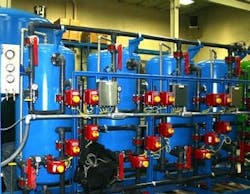Contaminant Removal in Colorado
Located in the heart of Boulder, Colo., the Two Nine North Apartments are eco-friendly luxury units built by Forum Real Estate Group in the late 2000s. Due to the high price per square foot of these apartments, the developer built the residents’ parking garage beneath the complex; however, it is below the water table and posed a threat to the building’s foundation.
At the beginning of the project, preliminary groundwater testing was performed, revealing iron and manganese concentrations below the surface water discharge levels for Boulder Creek. As construction progressed, the water quality was tested again, revealing an iron level of 4.6 mg/L and a manganese level of 4.2 mg/L, well above the surface discharge requirements of 0.3 mg/L and 0.05 mg/L, respectively. Forum Real Estate Group put a temporary dewatering system in place to remedy these high concentrations; however, a more cost-effective and permanent solution was needed.
Designing a Solution
In 2010, Forum Real Estate Group contracted JVA Inc. to provide civil engineering consulting services for the construction of the apartment complex. During the engineering phase, JVA contacted AdEdge Water Technologies LLC to design and implement an iron and manganese dewatering system for the site.
The treatment system AdEdge provided is a skid-mounted oxidation and filtration packaged unit rated for a maximum design flow of 50 gal per minute (gpm) and a skid-mounted granular activated carbon (GAC) packaged unit also rated for a maximum design flow of 50 gpm. AdEdge Package Unit systems are designed as turnkey treatment solutions for a variety of contaminants, including arsenic, iron, manganese, uranium, nitrates and turbidity.
Treatment System Operation
Prior to entering the treatment system, the raw water is injected with liquid sodium hypochlorite via an AdEdge ADIN chemical feed module to oxidize the iron and enhance its receptivity to the AD26 media. After the chemical introduction, the raw water is treated in the iron and manganese treatment system using the media. The treatment system’s four carbon steel vessels are configured in parallel and each vessel utilizes 14.7 cu ft of media. The NSF 61-certified manganese dioxide media is highly catalytic for the oxidation and filtration of arsenic, iron and manganese.
After the AD26 treatment system, the water is treated by a second system utilizing AdEdge GAC media. The GAC treatment system consists of two vessels configured in parallel, each containing 30 cu ft of media that act as a polishing filter for dechlorination and the removal of organics, in accordance with surface water discharge requirement. The GAC system is completely manual. In December 2011, a dechlorination chemical feed pump was added to help meet the discharge requirements.
The AD26 system is equipped with automatic control valves and a harness, a central control panel with a programmable logic controller (PLC) and a color user interface screen. The PLC performs the automated functions needed for operating the control valves, regulating and monitoring system pressure and differential pressure to initiate backwashing, alarm status and other parameters.
Other system features include differential pressure switches, control panel and local gauges, flow sensors and totalizers, and a central hydraulic panel with sample ports. An autodialer was integrated into the system so that an operator could be contacted in case of an emergency.
The PLC initiates backwashing of the AD26 treatment system two to three times per day depending on the incoming levels of iron and manganese to remove any suspended solids that may accumulate in the bed. In addition to the AD26 and GAC systems, AdEdge provided a backwash supply system and an H2Zero backwash recycle system that reclaims 100% of the settled backwash water. The settled iron, manganese and suspended solids form a low-percent-solids sludge that is removed every 30 to 40 days by a contracted VAC-Truck.
Backwashing of the GAC treatment system is performed manually by the operator about every 30 days and the backwash wastewater is recycled to the backwash recycle tanks. The backwash water is stored in two 3,000-gal holding tanks. The supernate water from the backwash recycle tanks is pumped back into the head of the system prior to the AD26 system for 100% recovery of recycled water.
Meeting Requirements
The AdEdge treatment system began operation in March 2011 and has experienced little to no downtime since installation. Approximately 60,000 gal of water daily with iron and manganese levels exceeding 4.6 mg/L and 4.2 mg/L, respectively, is treated to below the treatment goals of 0.3 mg/L for iron and 0.05 mg/L for manganese for surface water discharge.
Download: Here
